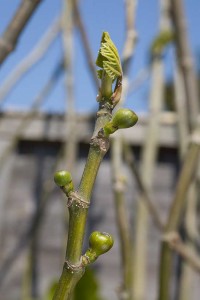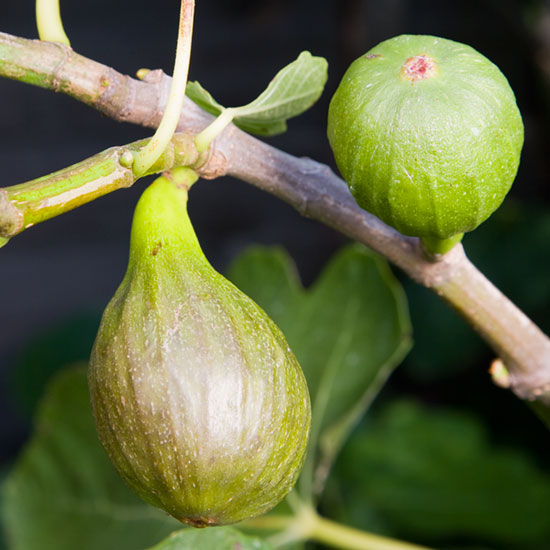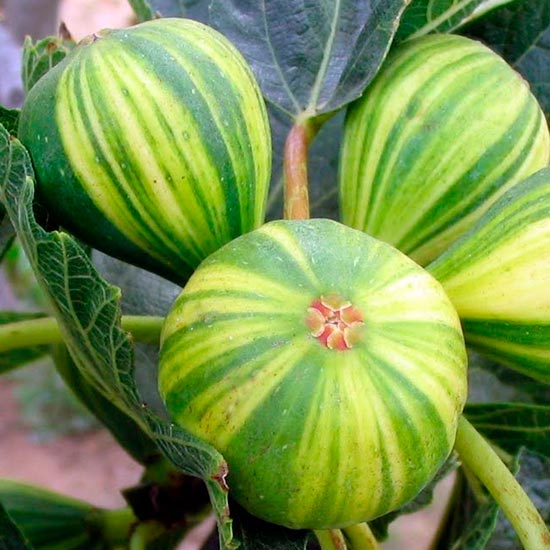Contrary to popular belief figs will grow very well in this country and have so for hundreds of years. Although they originate from warmer parts of the world such as Persia and Syria (where they were recorded as long ago as 2900 BC) they can be very long lived in this country even if, on occasion, they may be cut back severely by frosts. It is said that fig trees growing at Lambeth Palace were planted in the mid-16th century despite being cut to the ground on several occasions by frost. There used to be a very successful fig garden at Tarring, near Worthing which is reputed to have been established in the mid eighteenth century but in recent years it has been destroyed by developers, despite a number of attempts to preserve it as a deserved heritage feature.
Incidentally figs are classified into four groups overall of which the Common or Adriatic fig is the one that is of interest to us as it develops its fruit without pollination and does not rely on the services of the fig wasp (which will only survive in warmer climates) to pollinate it. So now you know – a useful piece of trivia!
Figs are ideal for growing at home because, in my opinion, they are one of those fruits which can only be best enjoyed when picked ripe from the tree – as soon as they are picked they start to lose their flavour and this is often not appreciated by those who purchase their figs from the supermarket. To be really honest eating a fig that is warm from the sun and freshly picked is almost like enjoying heaven (or something similar!) – utterly delicious in all respects and they do you good at the same time as they contain iron, calcium and Vitamins A and C. However, do not get carried away by eating too many as unpleasant side effects can occur!
Figs can be cultivated outdoors or under heated glass and it is possible to achieve two crops in a year if the latter method of cultivation is followed. Although figs will grow outdoors very well they are best grown in a warm position but be prepared to cover them if cold weather is forecast. In the colder areas of the country it is essential to grow the hardiest varieties if growing outdoors as it is very likely that they will be cut back by the cold weather unless fully protected. Such protection may either mean moving a potted tree under cover where it is kept above freezing or the tree is wrapped in straw or similar.
Figs can be grown in pots or in the open ground and will do best in a warm, well drained position but will need plenty of water in the summer. Figs naturally tend to grow large before they fruit well but in the garden they can be persuaded into fruiting at a very early stage by restricting their roots, planting them in a poorish soil and not feeding them. Root restriction is easy when growing in a pot but can be easily achieved in the ground by digging a hole and then lining it with paving slabs. The fig is then planted in the resulting hole and should soon be forced into fruiting. This root restriction must be continued or the tree will cease to fruit in quantity. You have been warned! Another option is to grow your fig in the ground using a Root Control Bag. These bags will control roots just as well as paving slabs and are a lot easier to use!
Where pots are used it is not only possible to grow bush trees – which is the norm – but also standard trees which look particularly fine. I would recommend this where growing space is limited and where you would like some more statuesque fruit trees. Pomona Fruits are currently able to supply ready trained standard fig trees of the variety ‘Brown Turkey’ but it is possible to train any variety in to this form.
Figs are usually grown as bushes but fans are perhaps the ultimate way of growing them. Such a fan will certainly be a good looking addition to a fruit garden or allotment and if trained against the wall of your house or shed it will add an air of distinction and when fruiting well it is a sight to behold. In the fig fruiting season you will become very popular with friends, family and neighbours!
Above all figs are very easy to grow and perhaps need the least attention of any fruiting crop other than to keep them well watered if growing in a pot, giving them protection in cold weather and eating the resulting fruits! However, if you want to ensure that you have a regular and successful crop it is important to understand the fruiting pattern of figs in this country. The first and usually most successful crop begins its life as embryo fruits produced in late summer at or around the tips of the young shoots. These baby fruits are very small – often smaller than peas – but provided that they are not affected by cold weather they will develop and ripen the following summer. If these embryo fruits are not protected against cold weather they will simply fall off.
It is highly possible that in the warmest areas of the country that never suffer from frosts or cold winds or where they are grown in very sheltered conditions figs need no further protection. However, I would not personally take the risk, particularly with young trees, and lose all of my crop. Embryo fruits are again produced in the spring and these are unlikely to ripen if the fig is grown in the open as our summers are simply not long and warm enough. If this is the case these should be removed at the end of the summer to ensure that the tree puts all of its resources in the overwintering fruits. If, on the other hand you are growing your figs under glass, with some heat in late summer and early autumn you will be able to ripen these figs as well giving you a second crop. However, in my experience the first crop will usually produce the finest fruits as all of the tree’s energy has been put into them. The second crop, whilst good, will not produce the same quality fruits.
Figs are generally very easy to maintain provided they are grown with good root restriction. Pruning is mainly formative and then to keep them at whatever size is required. In early summer after the new shoots have grown out the growing point should be cut off when they have made four or five leaves. It is important that this pruning is done at this point in time as it will allow the shoots to ripen and then allow the embryo fruits to form. If pruning takes place after this you will either prune the crop off or cut away the shoots where the embryo fruits will form.
A further prune can take place in late winter or early spring when all dangers of frost have passed. At this time all wood that is dead, diseased or damaged should be cut out and branches thinned out if necessary to produce a well-balanced tree. This is particularly important where figs are growing in pots as wind can cause pots to topple over if the branch structure is unbalanced. You should always aim to create a shrubby habit to a fig growing in a pot as this will make a more stable and attractive feature.
Many experts will tell you to repot figs growing in pots every two years or so but I do not subscribe to this! Why make gardening even harder and time consuming? Yes attention should be paid to the pot you are growing your figs in – if you are growing in a very small pot and the tree has become quite big then you should consider a slightly larger pot and if roots are quite obviously being forced up out of the top of the pot or they actually break the pot you will need a slightly larger pot. However, in my experience figs can remain in their pots for up to five years as long as they are watered regularly and not allowed to grow into massive plants!
Figs are ready for picking as soon as they turn a little soft and start to hang downwards. Slight splitting of the fruits indicates absolute ripeness and occasionally a few drops of liquid exuded from the eye of the fruit will confirm this. As I noted earlier it is best to eat the fruits as soon as they are picked as they will quickly lose their flavour – in my experience picking from the tree and immediately eating them cannot be bettered!
So what about varieties? It is essential to grow only the hardiest in colder situations and where absolute protection cannot be guaranteed. However, if you live in a warmer part of the country, or can offer protection during colder weather by way of a greenhouse or a warm position there are a number of varieties which can be considered and reasonably easily acquired.
Brown Turkey is probably the best known and most widely grown fig due to its exceptional hardy qualities. It is early to ripen, an easy variety to grow and is a very good cropper. The fruits are large, pear shaped, purplish brown in colour and have a deep red flesh that is very sweet and rich. It is another fig ideal for growing in pots and it is a fairly moderate grower. It is perhaps the safest fig to grow in the colder parts of the country but, nevertheless, it is a quality fig well worth growing anywhere.
Brunswick will ripen in late August and is another popular variety. It is, however, a fairly vigorous growing tree and it is essential that the roots are well restricted if a good crop is to be obtained. Like Brown Turkey it is very hardy which will allow it to be grown in colder areas although protection may be required to overwinter the young crop. The fruits are very large – the largest of any of the figs suitable for growing in this country – are pale green with a brownish flush and have an orange red flesh that has a good flavour but which is only at its best when perfectly ripe.
Madeleine de Deux Saisons is one of the earliest figs to ripen and this will produce ripe fruits from June to mid-September. In a long and warm season it is possible this variety may produce two crops. The fruits are slightly rounder than most varieties and are medium in size with a golden brown skin and have a translucent pink flesh that is juicy and sweet. The tree is fairly hardy and can be grown outdoors but will need some protection during the colder months. It is an excellent variety for growing in pots.
Panachee (also known as the Tiger Fig due to its stripes) produces unusual fruits which are well striped in yellow and green. The flesh is a very bright red and has a superb sweet flavour. It is a reliable cropper and has a very good resistance to the cold.
My final selection is a fig that really needs to be grown in a warm location but which will repay this by producing fruits of exquisite quality and flavour. Rouge de Bordeaux produces its crop late in the season – August to September – and is ideal for growing in pots. It is one of the most delicious figs and compares very well to those grown in more southerly climates. The fruits are fairly large and roundish, reddish purple in colour with a heavy bloom and has a reddish brown flesh that is very sweet and rich. If you have a greenhouse that is warm in winter you must try this fig – when you eat it you will dream of the Mediterranean!
Go on have a go at growing figs – but do not eat too many at one time!
Gerry Edwards
7th August 2014
Gerry is an experienced amateur fruit grower who is Chairman of the RHS Fruit Group, a member of the Royal Horticultural Society’s Fruit, Vegetable and Herb Committee and also their Fruit Trials Panel. Gerry judges fruit nationally for the Royal Horticultural Society and is also a qualified National Vegetable Society judge.




I have had my fig tree that is in a large pot for 5 years now and is only just fruiting this year for the first time. It is called Continental Black. You haven’t mentioned this variety above. Can you tell me anything about this variety or has the nursery i bought it from mislabelled it.
Brian, this isn’t a variety we have heard of and it doesn’t appear to be listed on the RHS Plantfinder. As you say, it may have been mislabelled. Perhaps the nursery from where you purchased it brought it in from the continent and gave it a name just to describe it!
have no room for figs BUT WHAT A YEAR FOR RASPBERRIES ! your JOAN J bought 2 years ago- having to give a lot away as freezer is full and having strawbs and ice cream every night. thanks a million
We’re very glad to hear you are happy with your raspberries!
I have a lovely fig tree, I put it outside during the warmest weather, but, have now brought it into my conservatory ( not an all glass one ) where it likes to live over winter, It has now started to bear fruit which I am delighted with! I does seem to shed it’s larger leaves, I wondered if you could shed any light of this for me please? I don’t want to lose my lovely tree, it is in a pot, I have had the tree for around 3 years now if my memory serves me right? ( it probably doesn’t ! ). There are quite a few figs growing on it, and they are growing, there doesn’t seem to be a problem, I am just worried about the leaf-falling thing! I should say that the leaves were falling when it was outside too! Many thanks…Chrissie
Hi Chrissie, figs are deciduous so it is normal for them to drop their leaves overwinter. Defoliation can start from late summer onwards with some of the oldest leaves dropping first. However, a sudden change in growing conditions can also cause plants to defoliate prematurely and suddenly so moving the tree into a hot conservatory may have caused shock to the plant.
i have a standard fig tree in a pot and it fruits every year I had 132 figs on it this year and I leave it out all winter no probs as you say eat them straight from the tree they taste like heaven
I have a fig tree planted in the garden in a sunny position. It was planted about 10 years ago and it did not start to bear fruit until about 3 years ago. It does not produce a lot of ripe figs, although every year there are hundreds of embryo fruit on the tree at the end of the summer. This year it grew much more than in previous years and produced great many leaves. I wonder if the tree’s energy has been spent producing and keeping so many leaves at the expense of the fruit. If this is the case, what do I have to do to solve the problem? How can I stop the tree producing so many leaves? How can I ensure that a lot more fruit ripens. The roots of the tree are only partially contained in the ground with brick walls on 2 sides
Too much growth almost certainly means too much water / too extensive a root system / too many nutrients or just too young (it is perfectly normal for a fig to take 5 or 6 years to settle down and start cropping well). However if the tree is producing large numbers of fruitlets in late summer but they are not maturing, it may just be an issue of winter damage, in which case some fleece or extra winter protection might fix the problem.
Summer pruning (of the top growth) doesn’t really work with figs, and it is a really messy process – as they bleed milky sap all over the place (with risk of dermatitis). Root pruning however is worth considering (a right pain to do but it might work). I would suggest doing it over two years (as these roots can only be growing in 2 directions). Year 1: trench across one side, ideally 3-4ft deep, approximately 4 to 6ft away from the base of the trunk (depending on the size of the plant), severing all roots encountered. Before back-filling fix a barrier fabric the full depth of the trench or even brick rubble. Then a year later do exactly the same with the other side.